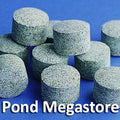

Marsh Marigold (Caltha Palustris) <br> 1st to bloom in spring! Weeks of flowers!
Plant Description
Marsh Marigolds, also known as caltha palustris or kingcup, have lovely, sunny-yellow, 1 - 2 inch blooms that adorn the Marsh Marigold in the spring along with attractive, glossy, green green foliage. Marsh Marigold is a perennial plant that blooms for a few weeks in early spring, adding color to an otherwise drab season! Marsh Marigold grows 10 - 16 inches tall in full sun to part shade. Marsh Marigold may wilt in the extreme summer heat but will make a comeback in the cooler fall weather! Marsh Marigold adds a cheerful touch in the pond or moist, bog areas around the pond. Marsh Marigold is an excellent pond plant for cooler weather and does extremely well in zones 3 - 6.
Height Grows 10-12 inches tall
Width 8 - 12 inch spread
Sunlight Requirements Full shade to part shade
Moisture Requirements Wet (Must be planted in loam soil ) and placed with up to 1 inches of water above the roots. It loves creeks and streams in shade or partial shade.
Soil Requirements Marsh Marigolds prefer Clay loam soil
Bloom Bright-yellow, early springtime blooms. Will re-bloom if cut back before seeding.
Zone Hardy in zones 3 - 6 , this will do poorly in hot summers.
Pondmegastore Tip: Cut the flowers back heavily on Marsh Marigold before they stop blooming and they should continue blooming again in summer.
Planting Instructions
Plant this perennial pond plant plant in a 1 gallon container or 8 inch fabric planting container, using heavy loam soil. Place in the pond with up to 3 inches of water over the roots, in full sun to part shade. Marsh Marigolds prefer clay soil, always add clay soil to your loam mix for Marsh Marigolds!
What Is Loam Soil?
Loam soil is a good mixture of Topsoil and Sand
If you are lucky enough to have good topsoil in your backyard, by all means, use your topsoil. All you will have to do is add fertilizer. If you are not so lucky--and your backyard is sand or heavy red or yellow clay, you can mix up a batch of loam soil.
You can create your own loam soil by mixing these two ingredients together
- 2/3 Inorganic Topsoil (Little or no organic material added)
- 1/3 Pool Filter Sand
Mix together thoroughly with a little water. Your soil should clump when squeezed. If your soil is mixed properly, it will not muddy your pond water.
You can purchase inexpensive bags of Topsoil at Lowes or Home-Depot. Don't buy brands like Scott's or Miracle-Gro, as they will contain too much organic matter that can foul your water. Buy an unbranded bag of topsoil instead.
You can purchase Pool Filter Sand at any store that sells pool supplies.
Marsh Marigolds prefer clay soil, make sure you add some clay to your loam soil mix for Marsh Marigolds!
Loam soil is well suited for all aquatic plants (except oxygenators). Oxygenators rarely need to be planted, just anchored in the substrate or in a container filled with sand or 1/8 inch pea gravel.
Sand holds little water but does allow for aeration and drainage.
Pondmegastore Tip In the south where there is extreme heat--Marsh Marigold will go dormant in summer but return the following spring.







